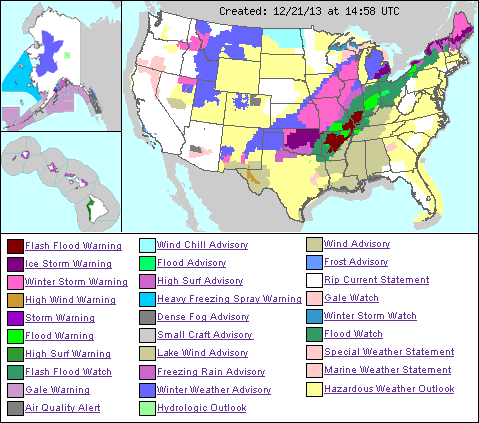EXTREME WEATHER EVENTS
Severe weather, damaging winds, heavy rain and flooding hit much of the U.S.
Multiple hazard warnings are in effect across much of the United States this weekend. The Warnings, Watches and Advisories issued by the National Weather Service (NWS) include Flash Flood Warning, Ice Storm Warning, Winter Storm Warning, High Wind Warning, Storm Warning, Flood Warning, High Surf Warning, Heavy Freezing Spray Warning, and Gale Warning.
Alerts for poor Air Quality and Hazardous Weather Outlook have also been issued by NWS.
“A mixed bag of hazards will be possible across much of the U.S. on Saturday. Severe weather with damaging winds and tornadoes will be possible from the Gulf Coast to the Ohio Valley. Heavy rainfall could cause flooding from the Ark-La-Tex into the Lower Great Lakes. And winter weather will impact the Northwest as well as locations from the southern Plains to New England.” —NWS

U.S. Weather Hazards Map (Hazmap) for Saturday, December 21, 2013. Source: NWS. Map Enhanced by FIRE-EARTH. UPDATE
U.S. Temperature Range: 103 degrees
High Temperature for Friday, December 20, 2013 (as received by 7 am EST December 21): 86 at Edinburg, TX
Low Temperature for Saturday, December 21, 2013 (as received by 7 am EST December 21): -17 at Bismarck, ND
Source: National High and Low Temperature (for the contiguous United States), NWS Weather Prediction Center, Issued 7 am EST Saturday, December 21, 2013
Global Temperature Analysis – November 2013
Global November average temperature was highest on record, while year-to-date global average temperature tied for fourth highest on record, reported NCDC/NOAA.
Global Highlights from NCDC Report
- The combined average temperature over global land and ocean surfaces for November 2013 was record highest for the 134-year period of record, at 0.78°C (1.40°F) above the 20th century average of 12.9°C (55.2°F).
- The global land surface temperature was 1.43°C (2.57°F) above the 20th century average of 5.9°C (42.6°F), the second highest for November on record, behind 2010. For the global oceans, the November average sea surface temperature was 0.54°C (0.97°F) above the 20th century average of 15.8°C (60.4°F), tying with 2009 as the third highest for November.
- The combined global land and ocean average surface temperature for the September–November period was 0.68°C (1.22°F) above the 20th century average of 14.0°C (57.1°F), the second warmest such period on record, behind only 2005.
- The September–November worldwide land surface temperature was 1.08°C (1.94°F) above the 20th century average, the third warmest such period on record. The global ocean surface temperature for the same period was 0.52°C (0.94°F) above the 20th century average, tying with 2009 and 2012 as the fourth warmest September–November on record.
- The combined global land and ocean average surface temperature for the year-to-date (January–November) was 0.62°C (1.12°F) above the 20th century average of 14.0°C (57.2°F), tying with 2002 as the fourth warmest such period on record.
Precipitation
… precipitation anomalies during November 2013 varied significantly around the globe… record wetness was observed during November over sections of coastal China, central Japan, north central Australia, and north central Mexico.
Record dryness observed across different parts of the globe, including some small sections of coastal South America, parts of north west Africa, a few regions of central and southern Asia, and parts of far west and southern Australia.
Parts of the United States had below average precipitation during the first 11 months of the year.
- California experienced a record low during the first 11 months of 2013.
Select National Highlights
- Russia observed its warmest November since national records began in 1891. Some areas of the Urals, Siberia, south of the Far East region, and on the Arctic islands in the Kara Sea had temperatures that were more than 8°C (14°F) higher than the monthly average.
- Parts of Southern Australia, southern Pakistan, a section of north east Kazakhstan, and eastern Tanzania were record warm. No region of the world’s land areas was record cold.
- Australia’s September-November mean average temperature was the warmest such period at 1.57ºC above the 1961-1990 average.
Recent Extreme Weather Events
- “Complex” Storm System Buffeting Central and Eastern U.S. December 14, 2013
- Two Winter Storms Impacting the U.S. December 7, 2013
- Major Winter Storm Battering Southern Plains through Ohio Valley December 6, 2013
- Major Winter Storm Affecting Much of the U.S. December 5, 2013
- Massive Winter Storm Engulfs Much of Western, Central and Northern U.S. December 4, 2013
- Massive Storm System Impacting Western and Central U.S. December 3, 2013
- Nor’easter Spawned by Deadly Thanksgiving Storm November 27, 2013
- Deadly Thanksgiving Storm Moves East November 26, 2013



